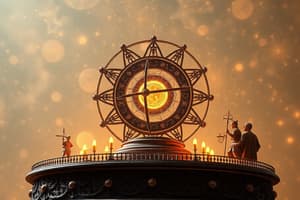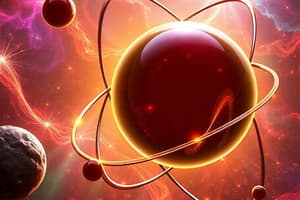Podcast
Questions and Answers
What concept did Democritus introduce regarding matter?
What concept did Democritus introduce regarding matter?
- Matter could be infinitely divided.
- Atoms could be created and destroyed.
- All elements have identical atoms.
- The atom is the indivisible smallest piece of matter. (correct)
What did John Dalton assert about the atoms of different elements?
What did John Dalton assert about the atoms of different elements?
- Atoms of different elements are identical.
- Atoms can be subdivided into smaller parts.
- Atoms can change into other elements.
- Atoms of different elements have unique properties. (correct)
Which model suggested that atoms are made of positive material with negative electrons embedded in it?
Which model suggested that atoms are made of positive material with negative electrons embedded in it?
- Billiard Ball Model
- Plum-Pudding Model (correct)
- Planetary Model
- Nuclear Model
What did Rutherford's Gold Foil Experiment reveal about atomic structure?
What did Rutherford's Gold Foil Experiment reveal about atomic structure?
What does quantum theory suggest about the absorption or emission of energy?
What does quantum theory suggest about the absorption or emission of energy?
In Bohr's model, what is true about electrons orbiting the nucleus?
In Bohr's model, what is true about electrons orbiting the nucleus?
What phenomenon did Einstein explain related to light interacting with metals?
What phenomenon did Einstein explain related to light interacting with metals?
What is a key aspect of the Law of Definite Proportions?
What is a key aspect of the Law of Definite Proportions?
Flashcards
Atom (Democritus)
Atom (Democritus)
The smallest particle of matter that cannot be broken down further (according to Democritus).
Dalton's Atomic Theory
Dalton's Atomic Theory
Proposed that all matter is composed of atoms, which are identical in size, mass, and properties for a given element. Atoms cannot be created or destroyed, only rearranged in chemical reactions.
J.J. Thomson's Model
J.J. Thomson's Model
Discovered the electron, a negatively charged particle that exists within a positively charged atom. Developed the Plum Pudding model - a sphere of positive charge with negatively charged electrons embedded.
Rutherford's Model
Rutherford's Model
Signup and view all the flashcards
Quantum
Quantum
Signup and view all the flashcards
Niels Bohr's Model
Niels Bohr's Model
Signup and view all the flashcards
Line Spectra vs. Continuous Spectra
Line Spectra vs. Continuous Spectra
Signup and view all the flashcards
Photoelectric Effect
Photoelectric Effect
Signup and view all the flashcards
Study Notes
Atomic Theory
- Democritus hypothesized that matter could be divided into smaller and smaller pieces until a point where it could no longer be divided.
- He called this indivisible piece an atom.
- Dalton stated that all matter is composed of extremely small particles called atoms.
- Atoms of the same element are identical in size, mass, and chemical properties.
- The atoms of different elements are different.
- Atoms cannot be subdivided or destroyed during chemical reactions.
- Atoms are combined, separated, or rearranged in chemical reactions.
- Atoms of different elements combine to form compounds that are always found in definite proportions.
J.J. Thomson's Model
- Discovered negatively charged particles called electrons.
- Proposed the plum pudding model, where electrons are embedded in a positively charged sphere.
Rutherford's Model
- Discovered a dense, positively charged nucleus at the center of the atom.
- Electrons orbit the nucleus in an empty space around the positively charged nucleus.
- Protons are found within the nucleus and are positively charged.
- Neutrons are also found in the nucleus and are neutral.
Origin of Quantum Theory
- Max Planck observed that excited gases produce a bright-line spectrum, meaning energy is emitted at specific wavelengths.
- Planck proposed that energy is emitted or absorbed in discrete, specific quantities called quanta.
Bohr's Model
- Bohr hypothesized that electrons orbit the nucleus in specific, allowed paths.
- Electrons in specific orbits have definite amounts of energy (quantized).
Einstein's Explanation of the Photoelectric Effect
- Einstein explained the photoelectric effect (light striking a metal and ejecting electrons).
- He suggested that light behaves as a stream of particles called photons, and each photon possesses energy.
- Photons with enough energy can cause electrons to jump to higher energy levels.
Louis de Broglie's Hypothesis
- De Broglie proposed that electrons exhibit both wave-like and particle-like properties (wave-particle duality).
Schrodinger's Model
- Schrodinger developed a model describing electron orbital clouds.
- The probability of finding an electron at a specific location around the nucleus is calculated.
- The location of an electron cannot be precisely determined; only the probability can be determined.
- This is because the act of measuring the electron affects its speed and position (Heisenberg's Uncertainty Principle).
Studying That Suits You
Use AI to generate personalized quizzes and flashcards to suit your learning preferences.




